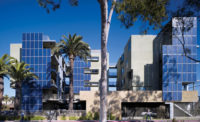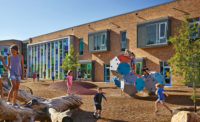Replicable test case in Colorado nears completion on time and within its
$64-million budget
The progressive aspect of the job—and a big departure for DOE—is that it was divided into three parallel design packages: site, shell and interiors. Similar to fast-tracking, the approach allowed the project to be done a couple of years faster than a design-bid-build approach.
But because DOE is not set up for fast-tracking, the DB team still had to respond to contract milestones at the end of schematic design, design development and construction documentation. However, the milestones did not coordinate with the way the team was packaging and delivering information. “We also needed to create document packages [for fieldwork] in the traditional way,” says Haselden.
In September 2007, DOE short-listed three of the 10 teams it had prequalified. In the RFP, instead of telling the three competitors what the building should look like, DOE and NREL defined what they wanted from the performance of the building. The RFP filled 506 pages, almost twice as many as is typical.
For starters, DOE wanted a building with the highest rating, Platinum, from the U.S.Green Building Council’s Leadership in Environmental Design (LEED) rating system. In the RFP, DOE and NREL included “aggressive” energy targets, says John Andary, principal in the San Francisco office of the project’s consulting engineer, Stantec.
To sign onto a firm-fixed-price contract, the competitors needed the best information possible, says Baker. To provide this, DOE and NREL held two separate meetings with each competitor to help refine the RFP. To keep a level playing field, all questions and all responses were posted to all competitors. “This was a way to reduce risk and increase the level of understanding,” says DOE’s Baker.
For the competition, DOE and NREL divided their needs for the building into mission-critical goals, highly desirable goals and “if possible” goals. “Mission critical” included attaining LEED Platinum and an Energy Star “Plus” rating from the U.S. Environmental Protection Agency. “Highly desirable” goals included capacity for 800 staff; 25,000 Btus per sq ft per year projected energy consumption, not counting the data center; documentation to produce a how-to manual; completion by 2010 and more. “If possible” goals included net-zero energy use, LEED Platinum Plus, a design model that achieved 50% better energy use than the prevailing code and more.
The teams had 10 weeks to develop proposals. Haselden and RNL decided to pull out all the stops and offer DOE a net-zero-energy-use building, which meant the architecture would grow out of the building systems engineering.
To achieve its goal, the team needed a superstar consulting engineer, says Macey. They approached Stantec’s John Andary, known for his expertise in energy-efficient building design.
For almost three weeks before Andary had even met any of his future teammates, Stantec, armed with the RFP, did numerous iterations of energy modeling and passive design simulations as well as massing, siting and solar shading studies. The team also selected a radiant heating and cooling system and a lighting system.
Tweaked
Within three days of the first DB team meeting, the concepts were solidified, says Andary. The next six weeks were spent doing continuous cost and energy modeling as “we tweaked the design,” he adds.
A lot of attention was placed on the building envelope. “You can either win or lose in the outward 2 ft of the building,” says RNL’s Hootman.
The design team completed what normally would be beyond schematic design-level documentation for the RFP. In March 2008, the Haselden team won the job in large part because it was the only team that offered a net-zero-energy building, says NREL’s Pless.
The building’s footprint resembles an eccentric letter “H.” The facility’s energy conservation includes many whistles-and-bells strategies. One novel system is thermal storage in the form of a heavy concrete crawl space, called a labyrinth, under the building’s footprint. The labyrinth provides additional capacity for passive heating and cooling.
The building also has transpired solar collectors on the south face. The system, developed by NREL, passively preheats outside air before it is delivered to an inside underfloor air distribution system. Net-zero energy is achieved by a 1.6-Mw rooftop photovoltaic system, added through a power-purchase agreement.
Baker is thrilled all of DOE’s performance goals were achieved at the RSF. But the missionary of green DB won’t be totally satisfied until the model is replicated far beyond DOE’s borders.





